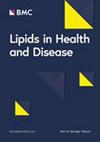PCSK9 inhibitors on the management of primary and secondary cardiovascular prevention
IF 3.9
2区 医学
Q2 BIOCHEMISTRY & MOLECULAR BIOLOGY
引用次数: 0
Abstract
Proprotein convertase subtilisin/kexin type 9 inhibitors (PCSK9i) have represented an important change in the management of hypercholesterolemia, although, until now, they have barely been used. Without PCSK9i, many patients with atherosclerotic cardiovascular disease (CVD) or those at very high risk do not reach their therapeutic LDLc objectives. The analysis aimed to examine the clinical and biochemical characteristics of subjects receiving PCSK9i treatment in the Dyslipidemia Registry of the Spanish Atherosclerosis Society. All consecutive subjects aged ≥ 18 years from different Lipid Units included in the Dyslipidemia Registry of the SEA were analyzed. Inclusion criteria consisted of unrelated patients aged ≥ 18 at the time of inclusion with hypercholesterolemia (LDL-C ≥ 130 mg/dL or non-HDL-C ≥ 160 mg/dL after the exclusion of secondary causes) who were studied for at least two years after inclusion. Participants’ baseline and final visit clinical and biochemical characteristics were analyzed based on whether they were on primary or secondary prevention and whether they were taking PCSK9i at the end of follow-up. Eight hundred twenty-nine patients were analyzed, 7014 patients in primary prevention and 1281 in secondary prevention at baseline. 4127 subjects completed the required follow-up for the final analysis. The median follow-up duration was 7 years (IQR 3.0–10.0). Five hundred patients (12.1%) were taking PCSK9i at the end of the follow-up. The percentage of PCSK9i use reached 35.6% (n = 201) and 8.7% (n = 318) in subjects with and without CVD, respectively. Subjects on PCSK9i and oral lipid-lowering agents with and without CVD achieved LDLc reductions of 80.3% and 75.1%, respectively, concerning concentrations without lipid-lowering drugs. Factors associated with PCSK9i use included increasing age, LDLc without lipid-lowering drugs and the Dutch Lipid Clinic Network (DLCN) score. However, hypertension, diabetes, smoking, and LDLc after oral lipid-lowering drugs were not independent factors associated with PCSK9i prescription. In subjects with CVD, the use of PCSK9i was higher in men than in women (an odds ratio of 1.613, P = 0.048). Approximately one-third of CVD patients received PCSK9i at the end of follow-up. The use of PCSK9i was more focused on baseline LDLc concentrations rather than on CVD risk. Women received less PCSK9i in secondary prevention compared to men.PCSK9 抑制剂在心血管一级和二级预防管理中的作用
Protein convertase subtilisin/kexin type 9 抑制剂(PCSK9i)是高胆固醇血症治疗中的一个重要变革,尽管到目前为止,它们还很少被使用。如果不使用 PCSK9i,许多动脉粥样硬化性心血管疾病(CVD)患者或高危人群都无法达到治疗性 LDLc 目标。这项分析旨在研究西班牙动脉粥样硬化协会血脂异常登记处接受 PCSK9i 治疗的受试者的临床和生化特征。对西班牙动脉粥样硬化协会血脂异常登记处不同血脂单位中所有年龄≥ 18 岁的连续受试者进行了分析。纳入标准包括纳入时年龄≥ 18 岁、患有高胆固醇血症(排除继发性原因后,低密度脂蛋白胆固醇≥ 130 毫克/分升或非高密度脂蛋白胆固醇≥ 160 毫克/分升)且在纳入后接受至少两年研究的无关患者。根据参与者是否进行一级或二级预防,以及在随访结束时是否服用 PCSK9i,对参与者的基线和最终访问临床和生化特征进行了分析。共对 829 名患者进行了分析,其中 7014 名患者在基线时处于一级预防状态,1281 名患者处于二级预防状态。4127名受试者完成了最终分析所需的随访。随访时间的中位数为 7 年(IQR 3.0-10.0)。随访结束时,有 500 名患者(12.1%)正在服用 PCSK9i。在患有和未患有心血管疾病的受试者中,服用 PCSK9i 的比例分别达到 35.6%(n = 201)和 8.7%(n = 318)。服用 PCSK9i 和口服降脂药的心血管疾病患者和非心血管疾病患者的 LDLc 降低率分别为 80.3% 和 75.1%,而未服用降脂药的患者的 LDLc 降低率为 80.3%。使用 PCSK9i 的相关因素包括年龄增长、未服用降脂药的 LDLc 以及荷兰血脂诊所网络 (DLCN) 评分。然而,高血压、糖尿病、吸烟和口服降脂药后的 LDLc 并不是与 PCSK9i 处方相关的独立因素。在心血管疾病患者中,男性使用 PCSK9i 的比例高于女性(几率比为 1.613,P = 0.048)。大约三分之一的心血管疾病患者在随访结束时服用了 PCSK9i。PCSK9i的使用更侧重于基线LDLc浓度,而不是心血管疾病风险。在二级预防中,女性接受 PCSK9i 治疗的人数少于男性。
本文章由计算机程序翻译,如有差异,请以英文原文为准。
求助全文
约1分钟内获得全文
求助全文
来源期刊

Lipids in Health and Disease
生物-生化与分子生物学
CiteScore
7.70
自引率
2.20%
发文量
122
审稿时长
3-8 weeks
期刊介绍:
Lipids in Health and Disease is an open access, peer-reviewed, journal that publishes articles on all aspects of lipids: their biochemistry, pharmacology, toxicology, role in health and disease, and the synthesis of new lipid compounds.
Lipids in Health and Disease is aimed at all scientists, health professionals and physicians interested in the area of lipids. Lipids are defined here in their broadest sense, to include: cholesterol, essential fatty acids, saturated fatty acids, phospholipids, inositol lipids, second messenger lipids, enzymes and synthetic machinery that is involved in the metabolism of various lipids in the cells and tissues, and also various aspects of lipid transport, etc. In addition, the journal also publishes research that investigates and defines the role of lipids in various physiological processes, pathology and disease. In particular, the journal aims to bridge the gap between the bench and the clinic by publishing articles that are particularly relevant to human diseases and the role of lipids in the management of various diseases.
 求助内容:
求助内容: 应助结果提醒方式:
应助结果提醒方式:


